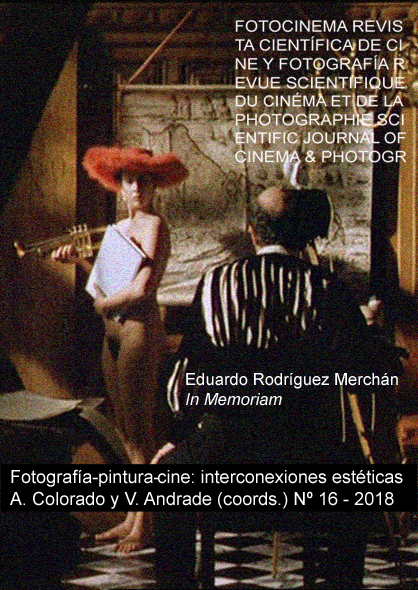Self-reflexivity in classic argentine comedy
DOI:
https://doi.org/10.24310/Fotocinema.2018.v0i16.4100Keywords:
Argentine Classical Cinema, Film Comedy, Self-Reflexivity, Entertainment Industry, Niní Marshall, Libertad Lamarque.Abstract
In the early 1940s, Argentine cinema was going through a process of industrial consolidation and the development of bourgeoisie-themed stories. Popular stars, who had ruled national film in the previous decade, faced the need to reformulate their characters and movies in order to keep their audience. In a scenario where film businessmen were getting rid of them and entertainment magazines criticized them, they looked for ways to insert themselves in this new context. A recurring strategy was self-reflective comedy, through which they dissasembled their implicit contracts with their audience by showing them the inner works of the entertainment industry. In these movies, they made explicit the transformations within the field and the possibilities they presented for popular actors. Stars such as Niní Marshall and Libertad Lamarque made use of this strategies to test alternatives, show their limitations and display the artificiality of film industry’s conventions.
Downloads
Metrics
Publication Facts
Reviewer profiles N/A
Author statements
Indexed in
-
—
- Academic society
- N/A
- Publisher
- Universidad de Málaga
References
Echart, P. (2005). La comedia romántica de Hollywood de los años 30 y 40. Madrid: Cátedra.
España, C. (2000). Pepe Arias. En C. España (Comp.), Cine argentino. Industria y clasicismo. 1933-1956. Tomo I (pp.168-170). Buenos Aires: Fondo Nacional de las Artes.
Feuer, J. (1995). The self-reflexive musical and the myth of entertainment. En B.K. Grant (Ed.), Film Genre Reader II (pp.441-455). Austin: University of Texas Press.
Gil Mariño, C. (2015). El mercado del deseo. Tango, cine y cultura de masas en la Argentina de los ’30. Buenos Aires: Editorial Teseo.
Karush, M. (2012). Culture of Class. Radio and Cinema in the Making of a Divided Argentina, 1920-1946. Durham: Duke U. Press.
Kelly Hopfenblatt, A. (2014). Un modelo de representación para la burguesía: La reformulación de identidades y espacios en el cine de ingenuas. Imagofagia. Revista de la Asociación Argentina de Estudios de Cine y Audiovisual, 10. http://asaeca.org/imagofagia/index.php/imagofagia/article/view/629/539
Kelly Hopfenblatt, A. (2015). Un cine en transición: el aburguesamiento del cine argentino visto a través de las revistas especializadas. Imagofagia. Revista de la Asociación Argentina de Estudios de Cine y Audiovisual, 12. http://www.asaeca.org/imagofagia/index.php/imagofagia/article/view/827
King, G. (2002). Film Comedy. London: Wallflower Press.
Lamarque, L. (1986). Libertad Lamarque. Buenos Aires: Juan Vergara.
Manetti, R. (2000). Argentina Sono Film. Más estrellas que en el cielo. En C. España (Comp.), Cine argentino. Industria y clasicismo. 1933-1956. Tomo I (pp.162-221). Buenos Aires: Fondo Nacional de las Artes.
Morales, I. (2016). Luis Saslavsky: Hollywood vivido e imaginado. AURA. Revista de Historia y Teoría del Arte, 4, 31-53. http://www.ojs.arte.unicen.edu.ar/index.php/aura/article/view/328
Paladino, D. (1999). Libertad Lamarque, la reina de la lágrima. Archivos de la Filmoteca 31, 60-75. Valencia: Filmoteca de la Generalitat Valenciana.
Pardo, S. (2017). Cine clásico argentino: espacio, mirada y autorreflexividad. Los casos de La trampa y Cosas de mujer. Dixit, 26, 74-83. http://revistas.ucu.edu.uy/index.php/revistadixit/article/view/1339
Rodríguez Riva, L. (2014). Cine, revista, música: la industria cultural en las primeras películas de Luis César Amadori. En R. Manetti y L. Rodríguez Riva (Comp.), 30-50-70. Conformación, crisis y renovación del cine industrial argentino y latinoamericano, (pp.49-71). Buenos Aires: Editorial de la Facultad de Filosofía y Letras, Universidad de Buenos Aires.
Savran, D. (2009). Highbrown/Lowdown. Theater, Jazz and the Making of the New Middle Class. Ann Arbor: The University of Michigan Press.
Tranchini, E. (1999). El cine argentino y la construcción del imaginario criollista. En El cine argentino y su aporte a la identidad nacional (pp.101-173). Buenos Aires: Honorable Senado de la Nación.
Downloads
Published
How to Cite
Issue
Section
License
All contents published in Fotocinema Revista científica de cine y fotografía are protected under the Creative Commons Attribution-NonCommercial-ShareAlike 4.0 International (CC BY-NC-SA 4.0) license. All about this license is available in the following link: <http://creativecommons.org/licenses/by-nc-sa/4.0>
Users can copy, use, redistribute, share and exhibit publicly as long as:
- The original source and authorship of the material are cited (Journal, Publisher and URL of the work).
- It is not used for comercial purposes.
- The existence of the license and its especifications are mentioned.
There are two sets of authors’ rights: moral and property rights. Moral rights are perpetual prerogatives, unrenounceable, not-transferable, unalienable, imprescriptible and inembargable. According to authors’ rights legislation, Fotocinema. Revista científica de cine y fotografía recognizes and respects authors moral rights, as well as the ownership of property rights, which will be transferred to University of Malaga in open access. The property rights are referred to the benefits that are gained by the use or the dissemination of works. Fotocinema. Revista científica de cine y fotografía is published in an open access form and it is exclusively licenced by any means for doing or authorising distribution, dissemination, reproduction, , adaptation, translation or arrangement of works.
Authors are responsable for obtaining the necessary permission to use copyrighted images.














13.png)



